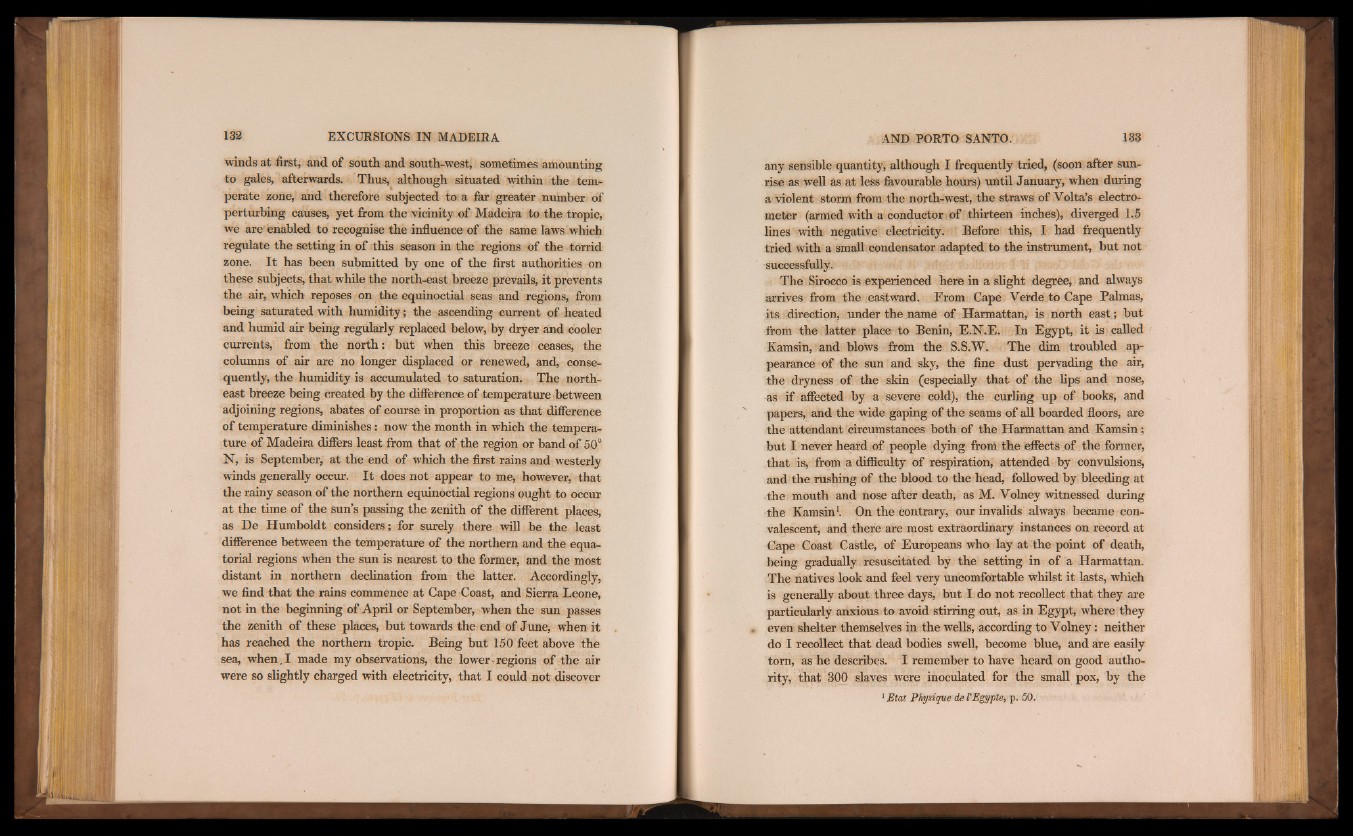
winds at first, and of south and south-west, sometimes amounting
to gales, afterwards. Thus, although situated within the temperate
zone, and therefore subjected to a far greater number of
perturbing causes, yet from the vicinity of Madeira to the tropic,
we are enabled to recognise the influence of the same laws which
regulate the setting in of this season in the regions of the torrid
zone. It has been submitted by one of the first authorities on
these subjects, that while the north-east breeze prevails, it prevents
the air, which reposes on the equinoctial seas and regions, from
being saturated with humidity; the ascending current of heated
and humid air being regularly replaced below, by dryer and cooler
currents, from the north: but when this breeze ceases, the
columns of air are no longer displaced or renewed, and, consequently,
the humidity is accumulated to saturation. The northeast
breeze being created by the difference of temperature between
adjoining regions, abates of course in proportion as that difference
of temperature diminishes: now the month in which the temperature
of Madeira differs least from that of the region or band of 50°
N, is September, at the end of which the first rains and westerly
winds generally occur. It does not appear to me, however, that
the rainy season of the northern equinoctial regions ought to occur
at the time of the sun’s passing the zenith of the different places,
as De Humboldt considers; for surely there will be the least
difference between the temperature of the northern and the equatorial
regions when the sun is nearest to the former, and the most
distant in northern declination from the latter. Accordingly,
we find that the rains commence at Cape Coast, and Sierra Leone,
not in the beginning of April or September, when the sun passes
the zenith of these places, but towards the end of June, when it
has reached the northern tropic. Being but 150 feet above the
sea, when,I made my observations, the lower regions of the air
were so slightly charged with electricity, that I could not discover
any sensible quantity, although I frequently tried, (soon after sunrise
as well as at less favourable hours) until January, when during
a violent storm from the north-west, the straws of Volta’s electrometer
(armed with a conductor of thirteen inches), diverged 1.5
lines with negative electricity. Before this, I had frequently
tried with a small condensator adapted to the instrument, but not
successfully.
The Sirocco is experienced here in a slight degree; and always
arrives from the eastward. From Cape Verde to Cape Palmas,
its direction, under the name of Harmattan, is north east ; but
from the latter place to Benin, E.N.E. In Egypt, it is called
Kamsin, and blows from the S.S.W. The dim troubled appearance
of the sun and sky, the fine dust pervading the air,
the dryness of the skin (especially that of the lips and nose,
as if affected by a severe cold), the curling up of books, and
papers, and the wide gaping of the seams of all boarded floors, are
the attendant circumstances both of the Harmattan and Kamsin ;
but I never heard of people dying from the effects of the former,
that is, from a difficulty of respiration, attended by convulsions,
and the rushing of the blood to the head, followed by bleeding at
the mouth and nose after death, as M. Volney witnessed during
the Kamsin1. On the contrary, our invalids always became convalescent,
and there are most extraordinary instances on record at
Cape Coast Castle, of Europeans who lay at the point of death,
being gradually resuscitated by the setting in of a Harmattan.
The natives look and feel very uncomfortable whilst it lasts, which
is generally about three days, but I do not recollect that they are
particularly anxious to avoid stirring out, as in Egypt, where they
even shelter themselves in the wells, according to Volney : neither
do I recollect that dead bodies swell, become blue, and are easily
torn, as he describes. I remember to have heard on good authority,
that 300 slaves were inoculated for the small pox, by the
1 Etat Physique de I’Egypte, p. 50.